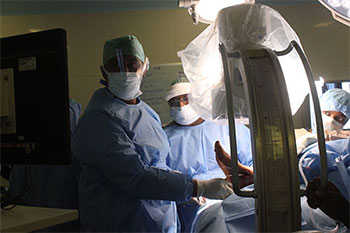Specialities
Understanding Keyhole Surgery
Keyhole, or arthroscopic surgery, is a highly specialized surgical procedure used by orthopaedic surgeons to treat medical problems inside a joint. It is called keyhole surgery because it is performed using tiny incisions and specialized surgical tools. The smaller the surgical incision, the lesser the scarring and faster the recovery.
What is Arthroscopy?
The term comes from a combination of 2 Greek words – arthro, which means joint, and skopein, which means to look inside. So, it is a procedure to look inside a joint to treat ailments or injuries. This minimally invasive orthopaedic surgery requires the use of the most modern equipment and procedures. An arthroscope is an instrument the size of a pencil that is inserted through a small incision. The arthroscope has a minute lighting system and camera that is used to transmit real-time images to a video monitor in the operating theatre. The surgeon can see the joint in detail, understand the nature and extent of the condition or injury and take action to treat it surgically. Initially, arthroscopy was a purely diagnostic process using a miniature camera, but the development of specialized surgical tools and techniques is now a complete surgical procedure.
Why is Arthroscopy or Keyhole surgery required?
Diagnostic imaging tests like X-ray, CT scan and MRI scan are sometimes not enough to understand the extent of the problem. This creates the need for an incisional or open surgery. Arthroscopy is a better alternative. By using a thin instrument like the Arthroscope, incisional surgery can be avoided. The doctor has enough time and ample imagery to make the necessary corrections. The minimally invasive procedure reduces bleeding, damage to surrounding tissues and recovery time. Arthroscopy is very effective in resolving joint conditions of the shoulder, elbow, wrist, hip, knee and ankle. It is used to examine inflammation, injury, ligament tears, tears in tendons or cartilage, and loose bodies at the joint.
How is Arthroscopy Performed?

Although arthroscopy, like other types of minimally invasive surgery, is better for the patient in terms of faster recovery, it requires the use of specialized equipment and surgical tools and is performed in an operation theatre.
The type of anaesthesia given will depend on the joint being repaired. Once that is done a small incision (or several incisions if the joint is to be viewed from different angles), the size of a keyhole, is made, and the arthroscope inserted. Once the Orthopaedic surgeon sees the extent of the problem, specialized miniaturized tools will be used to fix it.
What are the Benefits of Arthroscopy?
Arthroscopy allows the surgeon to have a close and transparent look at the joint that requires repair. He can see even the most minute details and accurately control the movement of the tools being used in the procedure. This is not only easier for the surgeon, but it also enables highly accurate and quick surgical actions to be performed.
The benefits to the patient include the following:
On which Joints can Arthroscopy be used?
Arthroscopy, either in the form of joint repair or minimally invasive joint replacement surgery, can be used to diagnose several joint conditions or injuries, including those affecting the:
What are the conditions that are treated by Arthroscopy?
What are the Risk Factors?
As with other forms of keyhole surgery, the risk factors for arthroscopy are less than traditional procedures. The risks, although rare, include:
It must be emphasized that complications occur in less than 1 percent of all arthroscopic surgeries, and if they do occur, effective treatment can be provided.
What is the Recovery Time?
As with all surgical procedures, the joint that undergoes surgery, the patient’s overall health, and other medical factors will impact the recovery. In general, the small incision will take a few days to heal. In most cases, the postoperative dressing can be removed the day after the surgery, and adhesive strips cover the healing incision. Although the incision and the joint pain are far less than with traditional surgical methods, it may take several weeks for complete recovery. Depending on the joint in question, rehabilitation or physiotherapy may be part of the recovery process. Depending on the joint, limited movement such as returning to the office or school or starting a few other daily activities may be possible a few days after the surgery.
